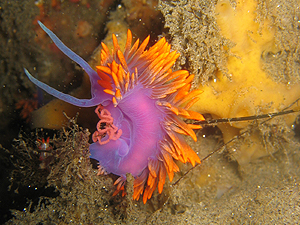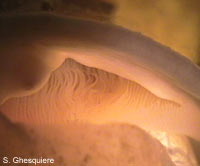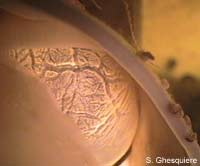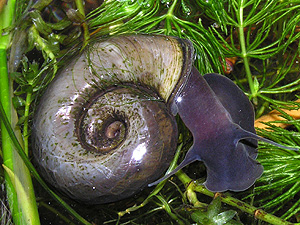
Flabellina iodinea, a nudibranch. Source: Wikipedia.
 Flabellina iodinea, a nudibranch. Source: Wikipedia. |
Snails have got a thin skin permeable for water. On one hand that means that water snails also can breathe through their skin. On the other hand that means that snails always have to face the loss of water through their skin.
Besides past their skin snails originally breathe by gills situated in the pallial cavity. The snails' gills look like a double comb, with a stem and feathery protrusions that are responsible for the general process of gas exchange: The absorption of oxygen from the water and the diffusion of carbon dioxide into the water. Those comb-like built gills are called ctenidia. Though, only archaic snails have got two of them, usually one ctenidium is reduced. Besides, the stem usually melts with the pallial cavity's roof and the second row of feathers is also reduced, so that only the stem and one row of feathers remain.
Some snail groups secondarily build further gills. Limpets (Patella) for example have got several gill filaments in the pallial groove between foot, mantle and shell. The sea slugs called nudibranchs on the other hand have their mantle reduced as well as their gills (together with the pallial cavity). The resulting necessity of skin-based respiration during evolution led to the development of dorsal protrusions of these sea slugs, that are used for breathing and gave the group the name Nudibranchia, which means nude gill animals, as their gills are not hidden in the pallial cavity but showing into the water.
Respiration and circulation of a terrestrial snail (Helix pomatia).
![]() Pictures on the right: Respiratory organs of a fresh water snail (Asolene
megastoma). Picture source: Stijn Ghesquiere: applesnail.net.
Pictures on the right: Respiratory organs of a fresh water snail (Asolene
megastoma). Picture source: Stijn Ghesquiere: applesnail.net.
 Gill (Ctenidium) |
|
 Blood vessels of the lung. |
The farthest reaching adaptations concerning the respiration have happened
during the evolution of terrestrial snails. The primary gill had to be reduced,
as breathing air with gills is impossible. Instead a network of capillary blood
vessels on the rear wall of the pallial cavity was developed, that represents a
simple lung, as oxygen is able to diffuse into the blood through the capillaries'
walls, as well as carbon dioxide is able to leave the blood. Lung snails (Pulmonata)
are able to close the opening of the pallial cavity by a ring muscle to prevent
too high loss of water by evaporation. The process of breathing happens by
lowering and rising of the pallial cavity's floor, about the same way as the
human diaphragm is used.
Snails of border areas between land and water have achieved further interesting
adaptations.
Pond snails (Lymnaea) for example are able to fill their pallial
cavity with water and to acquire oxygen from it, though they are pulmonate (lung)
snails. They do so especially when the pond they live in is frozen.
Ram's horn snails (Planorbidae) possess a strongly blooded mantle lobe that serves the
water pulmonate snails as additional (accessory) gill, especially to get rid of
carbon dioxide.
 Ram's horn snail (Planorbarius corneus).[RN] |
The snails' blood not only serves to transport respiratory gases and nutrients. It also is the antagonist of the retractor muscles. There are on one hand muscles, that withdraw the important parts of the snail, such as Tentacles, as well as all of the snail's body (main retractor muscle), but on the other hand no muscle can push out a tentacle again. That happens by blood pressure. The snail's penis also is pushed out by blood pressure and withdrawn by muscle action after the process of mating. Snails consist of blood to 20 to 50 %, the sea hare's (Aplysia) body weight is about 75 % blood.
Most snails' blood pigment is haemocyanin. Contrary to haemoglobin, used by vertebrates, haemocyanin works on a complex with copper as oxygen binding atom. That is why snail blood in its oxidised state appears pale blue in colour.
Less often snails also use haemoglobin (the ram's horn snail Planorbis does), the blood pigments are different between snail groups. Snails' heart lies near the respiratory organs. Snails with transparent shells, such as Vitrinidae (glass snails) or Succineidae (amber snails) offer the possibility to see the heart without having to kill the snail. Snails usually have two heart chambers, one atrium and one ventricle. Few groups have two atriums, making the heart a three-chambered one. There is a valve between atrium and ventricle to prevent the blood from flowing back. Snails' circulation basically is open. The exception are few large blood vessels, that transport blood for example to the visceral sac or to the foot. Besides that the blood circulates freely in so called lacunae or sinuses, body cavities incompletely separated from each other by tissue walls.